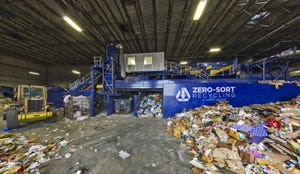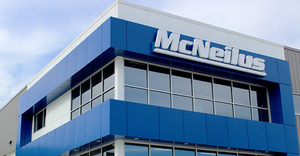Indian River County, Fla. Community Fridge Tackles Two Food-Related Problems
Community Fridges are popping up in scattered spaces around the country, enabling people to give and receive food that would otherwise get thrown out. Indian River County, Fla. has launched such a program, pulling in support from neighborhood businesses, local city and county government, volunteer organizations, first-graders to high-schoolers, among others.

Community Fridges are popping up in scattered spaces around the country, enabling people to give and receive food that would otherwise get thrown out.
Indian River County, Fla. has launched such a program, pulling in support from neighborhood businesses, local city and county government, volunteer organizations, first-graders to high-schoolers, among others.
The idea started with Sue Flak, Recycling Education and Marketing coordinator for Indian River County.
“Addressing food waste had been on my bucket list for a long time. [Typically] more than 50 percent of what goes to municipal solid waste landfills is food, and it gives out twice the methane as other waste types,” she says.
She wanted to find a way to lessen the landfill load that would also help the many food-insecure people living in low-income neighborhoods in Fellsmere, Fla.. The fridge is located near where they live and work— right in the middle of the City Hall complex.
It’s a key location because there is a constant flow of activity between Boys and Girls Club events, an annual festival, and other neighborhood celebrations.
There’s a lot of food out there, but accessing it requires setting up logistics to recover it and having a large network of support.
Most of it comes from three main sources: a local food pantry, Publix, and Panera Bread.
Flak went to MEANS Database, a nonprofit organization involved in food recovery, who provided a stipend to pay a driver who collects from the stores weekly to every few nights.
“We get about 40 pounds a day from each of these stores that would otherwise go in the trash. They are grateful that we take it,” Flak says of the operation that started with four volunteers who reached out to people they knew. From there what began as a small pilot mushroomed.
Some of the food comes from other businesses and community events, as well as local farmers who donate edible food that they can’t sell, usually because it does not have the appearance that restaurants and grocery stores expect.
In the beginning, Flak was simply looking for a plug-in wall outside of a building with an overhang to protect the fridge and residents in bad weather.
But Keith Touchberry, Fellsmere’s chief of police, knew of a city-owned utility and storage building with a room that was about to be vacated.
“I ran a request [to set up the fridge there] through the City Council, who thought it was a great idea. We were already doing food distributions in that parking lot,” Touchberry recalls.
“Sue had just wanted a fridge, but we saw could do more, so we helped retrofit the room.”
New lighting and electricity were installed for the purpose of the reinvented space. Old shelves were ripped out and replaced with new units to store dry goods. A bulletin board was set up for people to leave requests for what they needed.
The community came together to bring together more pieces.
A resident donated the fridge. A local artist designed the layout for a painting on the outside of the unit. The Boys and Girls Clubs and elementary school students took paint brushes and filled in her outlines. Another local designer donated the sign that hangs above the door. And a Rotary Club group of high school students helped paint the inside of the building.
Indian River County’s food bank both receives and donates food to the community—serving 900 families a month who are food insecure.
“We want to distribute through the county, and the fridge gives us another location to do that,” says Scott Turner, president of the Food Pantry of Indian River County.
“There’s enough food in this country to feed everybody. But we see so much fresh vegetables and canned foods go to waste,” says Turner who also cooks at a nearby Salvation Army kitchen.
“They bring in truckloads they get from a local foodbank that would have been thrown out. We are here to bring that food back to people in need [through community resources including the fridge] while making sure it does not end up in landfill.”
Touchberry sees two additional benefits of the fridge: another way the city can partner with residents, nonprofits, and other governments to meet the needs of the community. And a way for the government to build trust between itself and citizens while giving people hope because they know food will be available for them should they be in need.
His department does a lot of social media to get the word out about this resource, including posting on its Facebook page, which has generated 12,000 followers.
Touchberry cut the ribbon at the fridge’s grand opening, before a crowd of city and county officials, civic groups, nonprofits, and citizens.
Getting buy-in initially took thought but was surprisingly easy, Flak says.
Mostly people needed to know that there truly were a lot of food insecure people living in Fellsmere – people who had jobs, like them, but needed supplements to get by from week to week or month to month.
There were questions around liability. Flak worked with agencies such as the Florida Department of Environmental Protection, Florida Department of Agriculture and Consumer Services, and the local Health Department to ensure food donors would be covered and to educate them on protections.
She and her team had a lot to learn too and turned to organizations who’ve run similar projects for guidelines and protocol, such as Buddy System Miami who has multiple community fridges. And they networked through Freedge, an international organization that links parties to community fridges around the world.
Looking back, Flak says, “This is not a project for the faint of heart, and you can’t do it alone. Networking is important. And a good volunteer base is key.”
Even today at every corner she and her team turn, they try and make another connection to face one of the biggest hurdles: keeping the fridge stocked.
There’s so much more food that can be recovered. It’s a matter of expanding logistics, Flak says.
That continues to be her main focus moving forward.
“I’d like to start collecting from other sources, like large events, and to eventually open another community fridge. Maybe working with community partners to iron out the logistics piece.”
About the Author
You May Also Like




